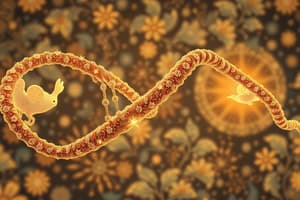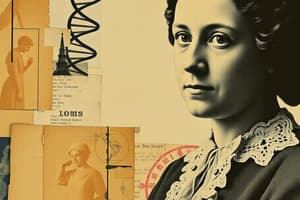Podcast
Questions and Answers
Who is known for discovering the two forms of DNA through X-ray diffraction images?
Who is known for discovering the two forms of DNA through X-ray diffraction images?
- James Watson
- Maurice Wilkins
- Francis Crick
- Rosalind Franklin (correct)
What was the key structural feature of DNA discovered by Watson and Crick?
What was the key structural feature of DNA discovered by Watson and Crick?
- Linear arrangement
- Double helix configuration (correct)
- Single-stranded structure
- Triple helix configuration
Which scientist collaborated with James Watson at Cambridge University to model the structure of DNA?
Which scientist collaborated with James Watson at Cambridge University to model the structure of DNA?
- Maurice Wilkins
- Rosalind Franklin
- Linus Pauling
- Francis Crick (correct)
According to Chargaff's Rule, what is one correct pair of nucleotide bases in DNA?
According to Chargaff's Rule, what is one correct pair of nucleotide bases in DNA?
What notable achievement did Watson, Crick, and Wilkins receive for their work on DNA?
What notable achievement did Watson, Crick, and Wilkins receive for their work on DNA?
What is nucleic acid?
What is nucleic acid?
What molecule carries genetic information?
What molecule carries genetic information?
What is the sugar molecule found in RNA?
What is the sugar molecule found in RNA?
What type of sugar is found in DNA?
What type of sugar is found in DNA?
Which of the following bases are purines?
Which of the following bases are purines?
In nucleotides, a sugar is attached to a phosphate group and a ______.
In nucleotides, a sugar is attached to a phosphate group and a ______.
What are the two components that form a nucleoside?
What are the two components that form a nucleoside?
What suffix is used for pyrimidine bases in nucleosides?
What suffix is used for pyrimidine bases in nucleosides?
Purines are single-carbon nitrogen ring bases.
Purines are single-carbon nitrogen ring bases.
How many nitrogen-containing heterocyclic bases are there in nucleotides?
How many nitrogen-containing heterocyclic bases are there in nucleotides?
The phosphate group is attached to the sugar at the c’______ position.
The phosphate group is attached to the sugar at the c’______ position.
Flashcards are hidden until you start studying
Study Notes
DNA Structure
- DNA is a double-stranded molecule twisted into a helix shape, resembling a spiraling staircase.
Key Scientists and Contributions
- Rosalind Franklin: Discovered the two forms of DNA using X-ray diffraction images in 1951.
- James Watson and Francis Crick: Worked together at Cambridge University to build physical models of DNA using wire, sheet metal, nuts, and bolts. They used Franklin and Wilkins' work to determine that DNA is a double helix and Chargaff's Rule to determine the base pairing.
- Maurice Wilkins: Collaborated with Rosalind Franklin on X-ray diffraction studies of DNA.
DNA Base Pairs
- Guanine (G) pairs with Cytosine (C).
- Adenine (A) pairs with Thymine (T).
Function of DNA
- The phosphate backbone of DNA is located on the outside, protecting the bases on the inside.
- DNA acts as a template for copying itself during cell division.
Nobel Prize
- Watson, Crick, and Wilkins were awarded the Nobel Prize in Physiology/Medicine in 1962 for their discovery of the DNA double helix structure.
Nucleic Acids
- Large biomolecules essential for all cells and viruses.
- Two types: DNA and RNA.
- DNA carries genetic information for organism development and function.
- RNA has structural similarities to DNA but is usually single-stranded.
Nucleotides: Building Blocks of Nucleic Acids
- Unbranched polymers made up of monomer units called nucleotides.
- Each nucleotide consists of a sugar molecule (ribose or deoxyribose), a phosphate group, and a nitrogen-containing base.
Pentose Sugars
- The sugar component of a nucleotide can be either ribose or deoxyribose.
- Ribose is found in RNA, while deoxyribose is found in DNA.
Nitrogen-Containing Heterocyclic Bases
- Five types of nitrogenous bases are found in nucleotides.
- Three are pyrimidine derivatives and two are purines.
- Pyrimidines: cytosine, uracil, and thymine.
- Purines: adenine and guanine.
- CUT: Cytosine, Uracil, Thymine (Pyrimidines)
- Pure As Gold (Pur AG): Purines are Adenine, Guanine
Phosphate Group
- The third component of a nucleotide is derived from phosphoric acid (H3PO4).
- Under cellular conditions, phosphoric acid loses two hydrogen atoms to form a hydrogen phosphate ion (HPO4).
Nucleotide Formation
- A two-step process:
- Step 1: Pentose sugar and a nitrogenous base react to form a nucleoside.
- Step 2: The nucleoside reacts with a phosphate group to form a nucleotide.
- Nucleotides are the building blocks of nucleic acids.
Nucleoside Formation
- Two component process:
- Pentose sugar (ribose or deoxyribose)
- Nitrogenous base (purine or pyrimidine)
Nucleoside Naming
- Named after the base they contain with a suffix:
- Pyrimidine bases: -idine suffix (cytidine, thymidine, uridine)
- Purine bases: -osine suffix (adenosine, guanosine)
- Deoxyribose: Prefix "deoxy-" is used.
- Ribose: No prefix is used.
Phosphate Group Addition to a Nucleoside
- Key Characteristics:
- The phosphate group is attached to the sugar at the C'5 position through a phosphodiester linkage.
- A molecule of water is produced in nucleotide formation.
- Overall: Two molecules of water are produced when a sugar, base, and phosphate are combined into a nucleotide.
Studying That Suits You
Use AI to generate personalized quizzes and flashcards to suit your learning preferences.





